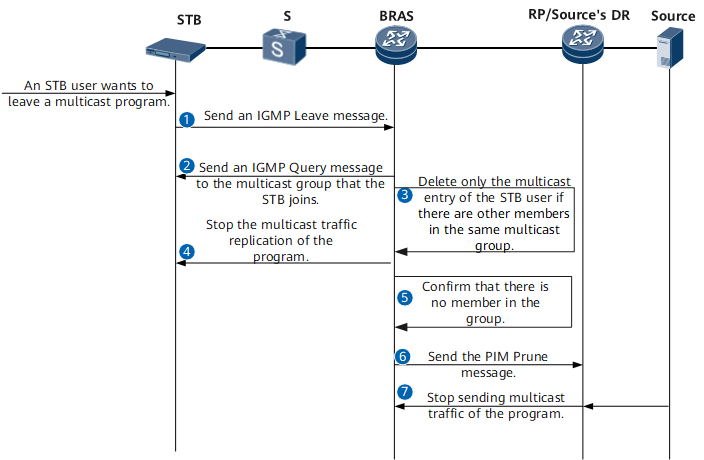Multicast Program Leave
To leave a multicast program, a user sends to an IGMP-capable BRAS an IGMP Leave message. Figure 1 illustrates the process of the multicast program leave. The key actions during this process are described in Table 1.

Session-based multicast replication is used in the following illustration of the multicast program leave process. Multicast program leave processes of other multicast replication modes are similar to that of session-based multicast replication.
Step |
Device |
Key Action |
|---|---|---|
|
STB |
To leave a multicast program, an STB user sends to an IGMP-capable BRAS an IGMP Leave message. Upon receipt of the message, the BRAS identifies the user and the multicast program that the user wants to leave. |
|
BRAS |
The BRAS sends an IGMP Query message to members in the multicast group specified in the IGMP Leave message it received. (If IGMP Prompt-Leave is configured, this step is skipped.) |
|
BRAS |
The BRAS deletes the multicast forwarding entry of the STB user only if there are other members in the same multicast group. (If IGMP Prompt-Leave is configured, this step is skipped.) NOTE:
If the STB user is not a member of any multicast group, the BRAS stops sending IGMP Query messages to the STB user after the robustness variable value is reached. |
|
BRAS |
The BRAS stops sending to the STB the multicast traffic of the corresponding multicast group it joined. |
|
BRAS |
If there is no member in the multicast group after the STB user leaves, the BRAS sends a PIM Graft message to the RP or source's DR to stop the multicast traffic replication to the group. |
|
RP/source's DR |
The RP or source's DR stops the replication of multicast traffic to the BRAS, ending the STB user leave process. |






